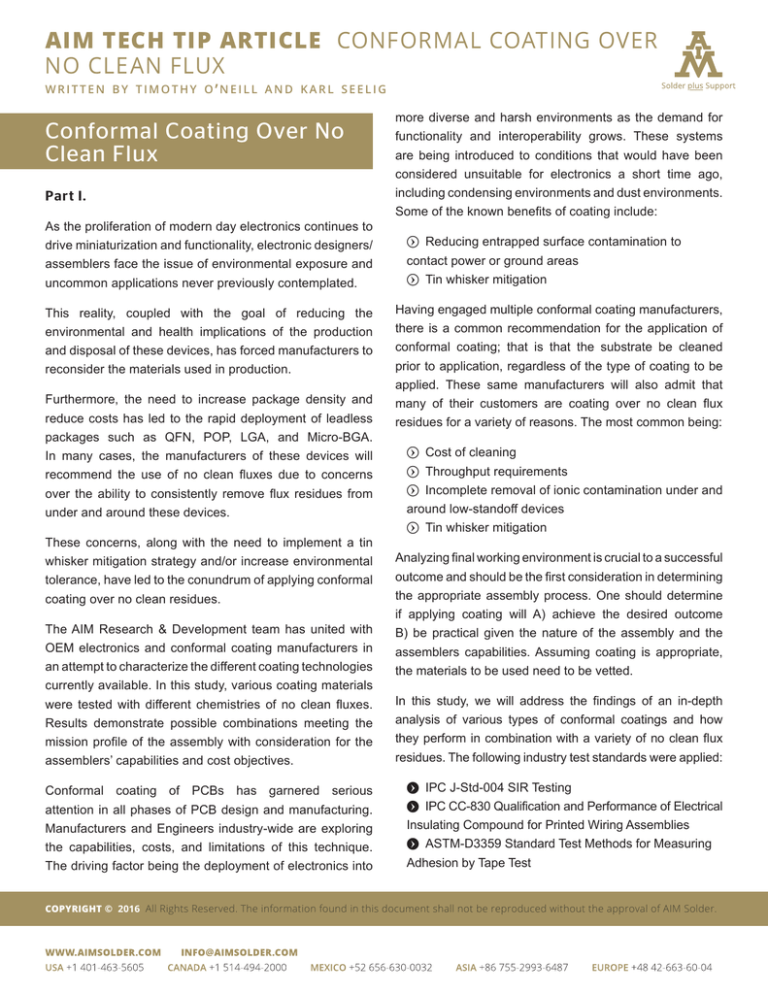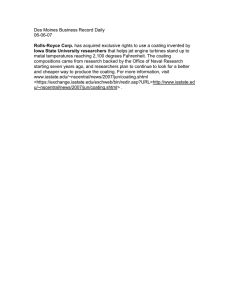
AIM TECH TIP ARTICLE CONFORMAL COATING OVER
NO CLEAN FLUX
written by timothy o’neill and karl seelig
Conformal Coating Over No
Clean Flux
Part I.
As the proliferation of modern day electronics continues to
drive miniaturization and functionality, electronic designers/
assemblers face the issue of environmental exposure and
uncommon applications never previously contemplated.
This reality, coupled with the goal of reducing the
environmental and health implications of the production
and disposal of these devices, has forced manufacturers to
reconsider the materials used in production.
Furthermore, the need to increase package density and
reduce costs has led to the rapid deployment of leadless
packages such as QFN, POP, LGA, and Micro-BGA.
In many cases, the manufacturers of these devices will
recommend the use of no clean fluxes due to concerns
over the ability to consistently remove flux residues from
under and around these devices.
These concerns, along with the need to implement a tin
whisker mitigation strategy and/or increase environmental
tolerance, have led to the conundrum of applying conformal
coating over no clean residues.
The AIM Research & Development team has united with
OEM electronics and conformal coating manufacturers in
an attempt to characterize the different coating technologies
currently available. In this study, various coating materials
were tested with different chemistries of no clean fluxes.
Results demonstrate possible combinations meeting the
mission profile of the assembly with consideration for the
assemblers’ capabilities and cost objectives.
Conformal coating of PCBs has garnered serious
attention in all phases of PCB design and manufacturing.
Manufacturers and Engineers industry-wide are exploring
the capabilities, costs, and limitations of this technique.
The driving factor being the deployment of electronics into
more diverse and harsh environments as the demand for
functionality and interoperability grows. These systems
are being introduced to conditions that would have been
considered unsuitable for electronics a short time ago,
including condensing environments and dust environments.
Some of the known benefits of coating include:
t Reducing entrapped surface contamination to
contact power or ground areas
t Tin whisker mitigation
Having engaged multiple conformal coating manufacturers,
there is a common recommendation for the application of
conformal coating; that is that the substrate be cleaned
prior to application, regardless of the type of coating to be
applied. These same manufacturers will also admit that
many of their customers are coating over no clean flux
residues for a variety of reasons. The most common being:
t Cost of cleaning
t Throughput requirements
t Incomplete removal of ionic contamination under and
around low-standoff devices
t Tin whisker mitigation
Analyzing final working environment is crucial to a successful
outcome and should be the first consideration in determining
the appropriate assembly process. One should determine
if applying coating will A) achieve the desired outcome
B) be practical given the nature of the assembly and the
assemblers capabilities. Assuming coating is appropriate,
the materials to be used need to be vetted.
In this study, we will address the findings of an in-depth
analysis of various types of conformal coatings and how
they perform in combination with a variety of no clean flux
residues. The following industry test standards were applied:
u IPC J-Std-004 SIR Testing
u IPC CC-830 Qualification and Performance of Electrical
Insulating Compound for Printed Wiring Assemblies
u ASTM-D3359 Standard Test Methods for Measuring
Adhesion by Tape Test
COPYRIGHT © 2016 All Rights Reserved. The information found in this document shall not be reproduced without the approval of AIM Solder.
The three standards applied to this study will determine
the SIR values and adhesion properties of each material
in combination. These figures were compared with supplier
provided data on the individual materials to determine if
characteristics were measurably enhanced or degraded
when combined. The classes of conformal coating materials
tested are outlined below.
Acrylics
Thermoplastics dissolved in solvents – no cross-linking
Strengths
Weaknesses
Air Dry
VOC Bearing Solvents
Easy Solvent Rework
Poor Solvent Resistance
Good Moisture Barrier
Flammable
Ease of Use
Soften in High Temp
Urethanes
Cure through cross-linking
All of the samples tested passed IPC SIR testing without
issue. An example of the data generated found below:
PASS-FAIL CRITERIA
IPC J-STD-004B §3.4.1.4.1
All measurements on all test patterns shall exceed 100 MΩ
No evidence electrochemical migration that reduces
conductor spacing by more than 20%
No corrosion of the conductors
TEST RESULTS
1. Test data, chart attached: Pass
2. Presence of dendrites: No
3. Maximum percent reduction of spacing: 0%
4. Presence of discoloration between conductors: No
5. Presence of water spots: No
6. Presence of subsurface metal migration: No
Original test data available upon request.
Strengths
Weaknesses
Solvent Resistant
Some Contain VOC's
RESULT CHARTS (1-3)
Humidity Resistant
Rework
Chart 1. “L” UV Cure Coated, “Paste 54” (Sn-Pb), Control
Abrasion Resistant
Cure Rate Environmentally
Dependent
Dielectric Properties
Worker Health Risks
Silicones
Cure through moisture cross-linking
Strengths
Weaknesses
Humidity Resistant
Abrasion
Moisture Resistant
Workplace Contamination
Flexibility
Temperature Tolerant
Acrylated Urethane
UV Curable Urethane
Strengths
Weaknesses
Protective Properties
Capital Investment
Through Put
Rework
Environment Impact
Shadowing
UV Inspection
COPYRIGHT © 2016 All Rights Reserved. The information found in this document shall not be reproduced without the approval of AIM Solder.
Chart 2. “H” UV Cure Coated, “Paste 54” (SAC305), Control
Chart 3. “H” UV Cure Coated, “Paste 54” (Sn-Pb), Control
Adhesion testing/thermal shock testing was originally
conducted on Practical Component SABER Test
Assemblies; however after multiple tests it was determined
that the required data could be collected using standard
B-24 test coupons. In addition to a considerable cost
savings, it eliminated variables that could have clouded
the results including the presence of ionics, mold release
agents and coating thickness variability.
125°C. Further examination revealed that there was
a cohesive failure of the flux residue, wherein the flux
remained firmly adhered to the PCB substrate and to the
coating, but failed internally (photo 3).
The findings of the adhesion testing yielded some favorable
and some unexpected results. The balance of this work
focuses on solder paste. We did not test wire solder
residues and all liquid fluxes where the conformal coating
wet and adhered to the substrate at the time of coating/
curing passed all subsequent tests.
Initial testing of thermal shock at -60°C - +125°C showed
gross delamination. Initially, it was thought the failure was
due to movement of the flux residue having softened at
This phenomenon was present on all coatings in varying
degrees (other than silicone). In general, UV materials
performed the worst, with solvent-based acrylics better
and silicones the best, with no delamination. A failure
was considered any evidence of delamination. It was
not determined if delaminated coating that remained
contiguous was still effective in protecting the underlying
substrate.
Ultimately, we found the modulus of the coating is directly
correlated to cold temperature failure. The CTE mismatch
of the residue and a high modulus coating were enough to
fracture the cold hardened flux residue. Flux medium used
in solder paste is typically a resin-based material and after
COPYRIGHT © 2016 All Rights Reserved. The information found in this document shall not be reproduced without the approval of AIM Solder.
reflow, the residue is hard. The colder the environment is,
the harder the residue. To test this theory, we varied the
residue and the coatings using harder and softer materials.
UV curable silicone having the lowest modulus of the
materials tested and UV cure urethane the highest. We
also tested a paste that is not resin based with residue that
is waxy, rather than hard. As depicted below, reducing the
modulus of either the coating or the residue eliminated the
delamination failure.
We also noted that solvent-based acrylic coatings
outperformed UV cured urethane materials although it
was product specific. It is believed that the solvent would
facilitate a more intimate bond between the residue and the
coating lessening the adverse effect of the CTE.
FIGURE 2. Results: 1 to 5 (worst to best)
The results indicated that the silicon did not delaminate.
Delamination is easy to see in the test as shown below.
The following profile was used.
We went a step further to determine what the lowest
temperature a resin based no clean paste and acrylic or
acrylate/urethane coating can withstand before suffering
delamination. The results of these tests were scattered,
but none of the material sets were capable of withstanding
more than -35°C for more than 10 cycles.
With this information, it would seem the simple solution to
this problem would be to incorporate a softer residue solder
paste to remedy the delamination issue. Unfortunately,
there is a significant impact to the SIR characteristics as
detailed below in FIGURE 1.
FIGURE 1. Moisture Absorption After Conformal Coat.
FIGURE 3. Profile used.
FIGURE 4. Pre Shock
FIGURE 5. Paste 55 Post T
Shock Delamination
FIGURE 6. Paste 16 (low/no
residue) Pre T Shock
FIGURE 7. Paste 16 Post T
Shock/No defects
COPYRIGHT © 2016 All Rights Reserved. The information found in this document shall not be reproduced without the approval of AIM Solder.
However if the solder paste is a low/no residue nitrogen
reflow solder paste delamination does not occur.
The following are a series of photographs that identify the hard
flux issue with delamination of a harder urethane coating.
PHOTO 4. Crystal flux residue stuck to the coating.
PHOTO 1. Delaminated after thermal shock testing.
PHOTO 2. Delamination lifting off board.
PHOTO 5. Close up of the above.
PHOTO 3. The crystal flux residue left on the board.
PHOTO 6. Close up of the above.
COPYRIGHT © 2016 All Rights Reserved. The information found in this document shall not be reproduced without the approval of AIM Solder.
Conformal coatings are not hermetic with all the materials
tested having varying degrees of moisture vapor
transmission. In this case, whereas moisture enters the
coating, the softer residue solder paste absorbs the
moisture and creates a “pressure cooker” of corrosion and
electrical failures (shown in FIGURE 9).
Pictured below in FIGURE 8 are SIR test results showing the
beginnings of dendrites. These were run in 85°C/85Rh. SIR
testing was also run at 40°C and 90 Rh. This test showed
less failures compared to the 85°C/ 85Rh.
FIGURE 10. Black Light/Good Adhesion
FIGURE 8. IPC 2.6.3.7 SIR Test (paste material coated with conformal
coating).
The below picture is of a comb pattern that was run at
85°C/85Rh. The dendrites are starting to grow.
FIGURE 11. White Light/Good Adhesion
CONCLUSION. This writing is a consolidation of hundreds
of tests and material combinations. The matrix of residues
and available coatings would be too large to contemplate.
The data has been edited to present key findings of
collected information and provide practical guidance for
engineers considering deploying this technique for their
assemblies.
FIGURE 9. Comb Pattern w/ Dendrites.
Adhesion to board and flux residues can also be determined
by using a crosshatch cut and applying tape to check
adhesion as shown in FIGURE 10 & 11.
Based on our findings, we have concluded that conformal
coatings can safely be used over no clean flux chemistry for
many types of assemblies. It is imperative that compatibility
testing be performed to ensure the coating provides the
intended protection and meets the mission profile of the
assembly.
COPYRIGHT © 2016 All Rights Reserved. The information found in this document shall not be reproduced without the approval of AIM Solder.
The incorporation of low standoff devices and the ability to
completely remove water soluble organic residues is driving
more assemblers to consider a no clean process. The risk
assessment of water soluble versus no clean in these
applications consistently favors no clean. The cost savings
in decommissioning the wash process and equipment is
another major reason for migrating to no clean chemistries.
Finally, as conformal coating continues to be the only
accepted practice for tin whisker mitigation, along with
the looming expiration of the RoHS exemption, we predict
no clean chemistries and the subsequent coating of the
resulting residues will become increasingly prevalent over
time.
COPYRIGHT © 2016 All Rights Reserved. The information found in this document shall not be reproduced without the approval of AIM Solder.



